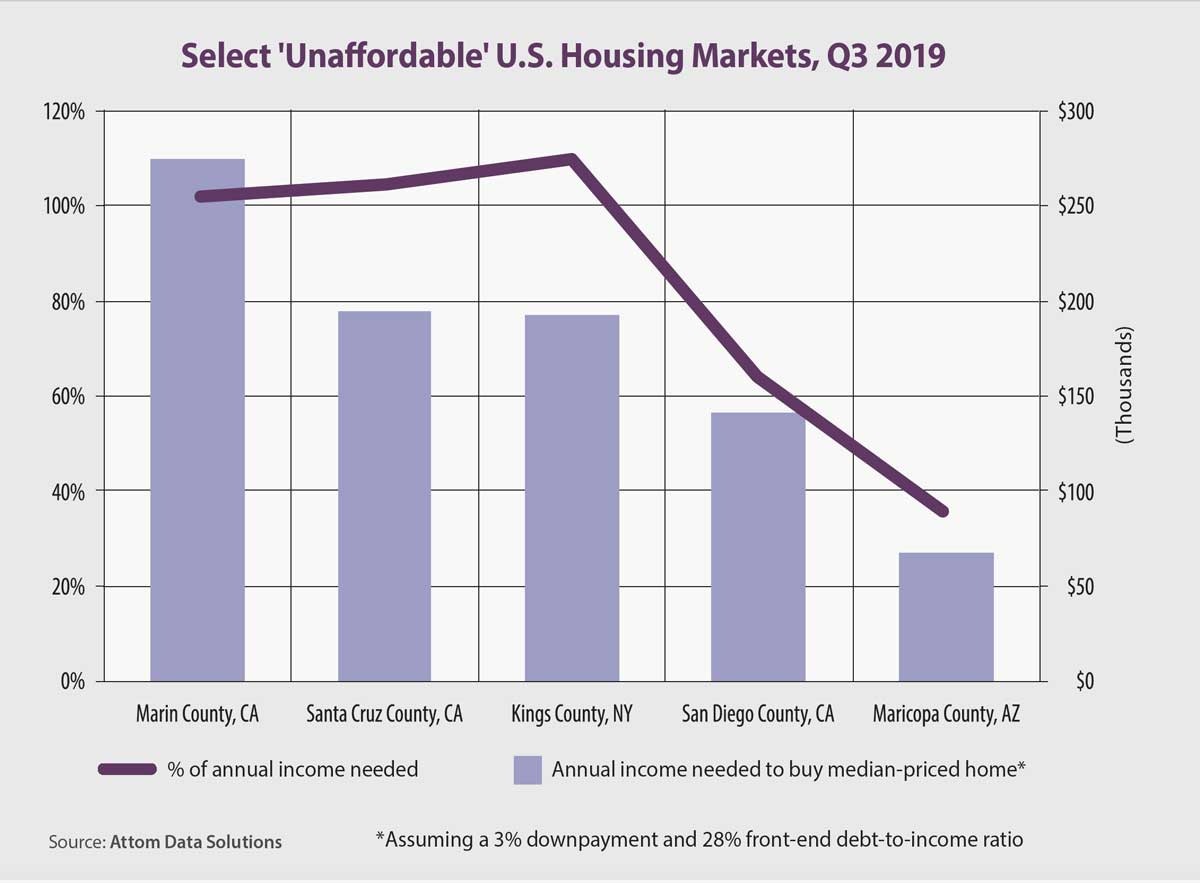With home prices continuing to climb, it’s becoming more difficult for the average U.S. wage earner to be able to afford to buy a home. According to the Federal Housing Finance Agency, home prices increased 5% from July 2018 to July 2019. Although that’s less than the 6.4% increase from July 2017 to July 2018, these increases are outpacing wage growth for the majority of U.S. housing markets.
In fact, according to Attom Data Solutions’ third-quarter 2019 home-affordability report, home-price appreciation outstripped wage growth in 76% of the housing markets analyzed. The report included data from 498 counties nationwide and 379 saw home-price growth outpace average weekly wage growth.
Many of the counties with the highest affordability gaps aren’t surprising to anyone with real estate expertise — these include Los Angeles County, California; Suffolk County, Massachusetts (which includes Boston); and Arlington County, Virginia (part of the Washington, D.C., metro area). The problem also persists outside the country’s largest metro areas, from Marathon County, Wisconsin, to Berks County, Pennsylvania.
According to the Social Security Administration, the average wage increased only 3.6% from 2017 to 2018. Clearly, this falls short of the 6.4% jump in home prices seen during the same time frame. Even though home-price appreciation is generally seen as a positive among real estate and mortgage professionals, it is causing serious issues for those looking to buy a home.
Attom Data found that median home prices in third-quarter 2019 were not affordable for average wage earners in 74% of the 498 counties surveyed. Some of the most-populous counties in which a median-priced home wasn’t affordable included the California counties of Los Angeles, San Diego and Orange; King County, Washington (Seattle); and Maricopa County, Arizona (Phoenix). Unsurprisingly, affordability improves away from the coasts and booming cities. The 26% of counties analyzed that had affordable median-priced homes in the past third quarter included Harris County, Texas (Houston); Wayne County, Michigan (Detroit); Cuyahoga County, Ohio (Cleveland); and the Pennsylvania counties of Philadelphia and Allegheny (Pittsburgh).
Although affordability is not an easy thing to gauge, the Attom Data report calculated affordability by determining the amount of income needed to make monthly mortgage payments (including property taxes and insurance) on a median-priced home, with an assumed 3% down payment and a maximum “front-end” debt-to-income ratio of 28%. Income amounts were compared to annualized average weekly wage data from the U.S. Bureau of Labor Statistics.
To better understand what these affordability figures mean in real terms, Attom Data determined that only one-third of the counties analyzed required less than 30% of annualized weekly wages to buy a median-priced home. So, for example, the average wage earner in Calhoun County, Michigan, needs 14.4% of their earnings to buy a median-priced home, while the average earner in Clayton County, Georgia, needs 15.2% of their wages.
For the remaining two-thirds of the housing markets analyzed, however, buyers need to pay at least 30% of their wages to acquire a home. In the priciest markets, these figures go much higher than 30%. In Kings County, New York (Brooklyn), the average wage earner would need to spend 110.4% of their annualized weekly wages to buy a home. In Santa Cruz County, California, that number is 105%. In Maui County, Hawaii, it’s 87.9%.
With figures like these, the goal of homeownership is becoming increasingly difficult for many dual-income households, not to mention single-income households. In fact, 61% of the markets Attom Data studied were less affordable than their historic averages this past third quarter. One bright spot for potential homeowners, however, is the recent decrease in mortgage rates. If these continue to stay historically low, this may help to make homeownership a greater possibility for the average borrower.
Author
-

Todd Teta is chief product and technology officer at Attom Data Solutions, where he leads the company’s technology and product teams. Prior to joining Attom Data Solutions, Teta led the product-development and technology organization at Meyers Research. Teta also previously co-founded several startups, including VisionCore, a company serving the mortgage and real estate data and analytics markets that was later sold to CoreLogic. He is a graduate of the University of Southern California, where he earned a degree in computer engineering and computer science. Learn more about Attom Data Solutions at attomdata.com.
View all posts







